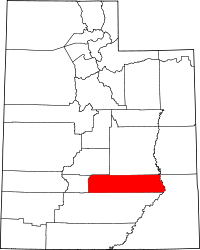Hanksville, Utah
| Hanksville, Utah | |
|---|---|
| Town | |
|
Hollow Mountain Store | |
 Location in Wayne County and the state of Utah. | |
| Coordinates: 38°22′17″N 110°42′47″W / 38.37139°N 110.71306°WCoordinates: 38°22′17″N 110°42′47″W / 38.37139°N 110.71306°W | |
| Country | United States |
| State | Utah |
| County | Wayne |
| Settled | 1882 |
| Incorporated | January 6, 1999 |
| Named for | Ebenezer Hanks |
| Area | |
| • Total | 1.9 sq mi (5.0 km2) |
| • Land | 1.9 sq mi (4.9 km2) |
| • Water | 0.04 sq mi (0.1 km2) |
| Elevation[1] | 4,295 ft (1,309 m) |
| Population (2012) | |
| • Total | 214 |
| • Density | 110/sq mi (43/km2) |
| Time zone | Mountain (MST) (UTC-7) |
| • Summer (DST) | MDT (UTC-6) |
| ZIP codes | 84734 |
| Area code(s) | 435 |
| FIPS code | 49-33100 |
| GNIS feature ID | 2412723[1] |
| Website |
www |

Hanksville is a small town in Wayne County, Utah, United States, at the junction of State Routes 24 and 95. The population was 219 at the 2010 census.[2]
The town is just south of the confluence of the Fremont River and Muddy Creek, which together form the Dirty Devil River, which then flows southeast to the Colorado River. Situated in the Colorado Plateau's cold desert ecological region it has, in Köppen climate classification, a temperate arid climate (BWk) with a mean annual temperature of 11.6 °C[3] and an annual mean rainfall of 146.3 mm (years 1961-1990).[4] The Hanksville-Burpee Quarry is located nearby, and the Mars Desert Research Station is 7 miles (11 km) northwest of town. The BLM Henry Mountains field station is located in Hanksville.[5]
History
The town was settled in 1882, and known for a time for the name given to the surrounding area, Graves Valley. It took the name of Hanksville in 1885, after Henry Golden, a former officer in the Mormon Battalion who was the leader of the group of pioneers who established the small Mormon settlement.[6] It was not incorporated until January 6, 1999.[7]
The REA brought electricity to the community in 1960. Today agriculture, mining, and tourism are the main drivers to the local economy. Tourism is particularly important with people coming for recreation at Lake Powell, Capitol Reef National Park, the Henry Mountains, the San Rafael Swell, Goblin Valley State Park, and the solitude of the surrounding deserts and slot canyons.
Hanksville was a supply post for Butch Cassidy and the Wild Bunch, who would hide out at Robbers Roost in the desert southeast of town.
During the uranium mining frenzy following World War II, Hanksville became a supply center for the prospectors and miners scouring the deserts of the Colorado Plateau. Many abandoned mines can be found in the deserts surrounding the town.
Demographics
| Historical population | |||
|---|---|---|---|
| Census | Pop. | %± | |
| 1890 | 81 | — | |
| 1900 | 46 | −43.2% | |
| 1910 | 77 | 67.4% | |
| 1920 | 141 | 83.1% | |
| 1930 | 81 | −42.6% | |
| 1940 | 129 | 59.3% | |
| 1950 | 129 | 0.0% | |
| 1960 | 169 | 31.0% | |
| 1970 | 181 | 7.1% | |
| 1980 | 351 | 93.9% | |
| 1990 | 324 | −7.7% | |
| 2000 | 362 | 11.7% | |
| 2010 | 219 | −39.5% | |
| Est. 2015 | 212 | [8] | −3.2% |
[10][11][12][13] As of the census[14] of 2010, there were 219 people residing in the town. There were 94 housing units. The racial makeup of the town was 98.2% White, 0.5% Asian, and 1.4% from two or more races. Hispanic or Latino of any race were 0.9% of the population.
Climate
According to the Köppen Climate Classification system, Hanksville has a semi-arid climate, abbreviated "BSk" on climate maps.[15]
References
- 1 2 U.S. Geological Survey Geographic Names Information System: Hanksville
- ↑ "Geographic Identifiers: 2010 Demographic Profile Data (G001): Hanksville town, Utah". U.S. Census Bureau, American Factfinder. Retrieved February 4, 2013.
- ↑ http://www.worldclimate.com/cgi-bin/data.pl?ref=N38W110+1302+423611C
- ↑ http://www.worldclimate.com/cgi-bin/data.pl?ref=N38W110+2300+423611C
- ↑ http://www.blm.gov/ut/st/en/info/directory/henry_mountains_field.html
- ↑ Van Cott, John W. (1990). Utah Place Names. Salt Lake City: University of Utah Press. p. 176. ISBN 0-87480-345-4. External link in
|title=(help) - ↑ Geographic Change Notes: Utah, United States Census Bureau, 2007. Accessed 2009-03-04.
- ↑ "Annual Estimates of the Resident Population for Incorporated Places: April 1, 2010 to July 1, 2015". Retrieved July 2, 2016.
- ↑ "Census of Population and Housing". Census.gov. Retrieved June 4, 2015.
- ↑ Census of Population, 1960: Total Population Counts for the U.S., States, Outlying Areas, Counties, Cities, Standard Metropolitan Statistical Areas, Urban and Rural, Etc. Characteristics of the population. Number of inhabitants. U.S. Department of Commerce, Bureau of the Census. 1961. pp. 2–.
- ↑ http://www.census.gov/prod/cen1990/cph2/cph-2-46.pdf
- ↑ Census of Population, 1960: Total Population Counts for the U.S., States, Outlying Areas, Counties, Cities, Standard Metropolitan Statistical Areas, Urban and Rural, Etc. Characteristics of the population. Number of inhabitants. U.S. Department of Commerce, Bureau of the Census. 1961-01-01.
- ↑ Census of population and housing (2000): Utah Population and Housing Unit Counts. DIANE Publishing. ISBN 9781428986244.
- ↑ "American FactFinder". United States Census Bureau. Retrieved January 19, 2012.
- ↑ Climate Summary for Hanksville, Utah
External links
| Wikimedia Commons has media related to Hanksville, Utah. |


